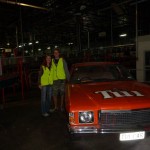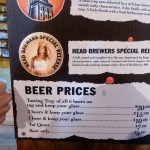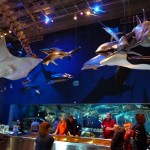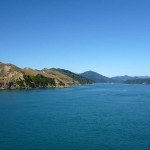Hi everyone, Andy’s back to pick up the story. So in the last two posts Emma told you all about our awesome three days of adventure, whitewater rafting, hiking an active volcano and free falling 47 metres with an elastic band around our ankles. Yes, they were three days that we wouldn’t be forgetting anytime soon. How could I forget that bungy jump when I was still blowing the Waikato river out from my nostrils four days later? Every night since as I lay waiting to drop off to sleep, I’d imagine being stood on the platform waiting to jump. The weight of the elastic already trying to pull me down as I looked out over the edge. The thrill of the sensation of free fall as I realised I was hurtling down and the icy shock as I hit the water of that beautiful blue river. Awesome. It gives me butterflies every time I think about it.
Heading south from Hawkes Bay we reached a small town in the middle of nowhere called Mangatainoka. If Hawkes Bay was famous for its wineries, well Mangatainoka is famous for being the home of the Tui brewery. Remember, the Tui beer that was partly to blame for my wicked hangover on New Year’s day? Well I’d forgotten about all of that already, so we rolled up in our trusty van and joined the brewery tour. Legend has it (or so the Tui beer labels say anyway) that one day, Mr Henry Wagstaff stopped to make a cup of tea using the water from the Mangatainoka river. He found the brew so delectable that he decided to build a brewery next to the river so that he could use this liquid nectar to make beer. Nice story. Turns out the Wagster was a bit of a lad, fathering many illegitimate kids and trying his hands at various trades all ending in disaster. Well apparently brewing was his calling in life. Tui isn’t too highly esteemed by serious beer drinkers, but it is certainly a Kiwi icon and along with Speight’s, makes most of the dollars spent in NZ’s pubs.
The tour was pretty light-hearted with just enough info so as not to bore anyone. After being shown the various stages of the brewing process and the crazy machinery in the bottling area, I was left amazed that eleven employees look after the whole brewery, pretty efficient I’d say. We were then all taken to the bar where we could try the beer. Standard Tui is an IPA and pretty inoffensive in every respect. As with all beers here and in Australia too, they are served ice-cold, like a lager would be back home. I don’t think the cold temperature does the beer any favours, taking away the subtle taste leaving only some maltiness left over. Tui and the other big names always make a point of telling you that their beers are brewed to the traditional 1800’s recipes, well that beer would have been drunk pretty warm back then and this I suspect is why the big name beers are pretty bland. Still, I forgive Tui as it’s named after my favourite NZ bird! We then tried Tui dark which was slightly more flavoursome but again not particularly memorable. We next tried the Head Brewer’s Special Reserve, apparently a beer that she, yes she has designed herself and proof that the girl knows what she’s doing. This one was really full-flavoured, very malty and with lots of hoppy aromas and bitterness too, if only you could buy this one in the pubs, it’s only available onsite at the brewery! Brewed by a woman, refreshing to hear and refreshing to drink! I hope that she’s as hot as all of the Tui girls in the adverts, I’m sure she is, “yeah right”. We excitedly collected our free Tui handles (glass tankards), putting aside the issue of how we’d transport them around for the remainder of our travels, my back’s not thanking me! We then spent half an hour pissing about with the huge Tui billboard where you can design your own Tui advert. Tui are famous for their “yeah right” ads seen on roadsides all over NZ, as an example “Of course I didn’t piss in your wetsuit mate….yeah right”. Check out the gallery to see what mischief we got up to 🙂 Even if you’re not the biggest fan of Tui beer, the tour is certainly a bit of fun and with three pints included (you can swap these for a takeaway bottle if you’re driving like we were), a Tui handle, 20% off merchandise in their shop and another free pint in a nearby pub, it certainly makes damn good value for $20, just over £10 at the time of writing!
Moving on, our next destination was a revisit to NZ’s cool little capital city, Wellington. As we drove towards it we followed the snaking Hutt river valley through some lovely native forest, apparently this river was used as the Anduin in Lord of the Rings. Remember the river by Rivendell that the Ring Wraiths couldn’t cross? Luckily there was no Elven magic to stop us that day, I just drove straight over a bridge. Ha ha! If you don’t know LOTR or don’t like it, then you can safely ignore everything I just said (weirdo). Arriving in Wellington, we left our van at a campsite and took a bus into town so as to avoid having to navigate the city’s maze of one way streets and ridiculous parking charges. We headed straight to Te Papa, the national museum of NZ. Te Papa is situated on the harbour’s edge, a huge 6 floor building with a very modern feel to its design. Huge full scale models of the three trolls from the new Hobbit film were stood in the foyer looking down on us like they would pick us up and gnaw the flesh from our bones any minute. Very cool to see and strikingly realistic, though come to think of it I haven’t ever seen a real troll to compare them to.
Being nature lovers, the most interesting part of the museum was the natural history section. I was wetting my pants at seeing Moa skeletons. These huge flightless birds once roamed the islands here, unfortunately for them, they proved to be just a bit too tasty to the Maori who ate the lot. With the Moa gone, the huge Haast eagle with its 4 metre wingspan no longer had any food and so too went the way of the Dodo. The Maori were however not to blame for the majority of extinctions, that one lies squarely with the settling Europeans in the 1800’s. One exhibit tried to recreate the sound of New Zealand’s forests in an age when man had yet to arrive. Stuffed specimens of the extinct species were on display, with simulations of their calls recreated from the accounts of the early explorers playing back, a haunting voice of the past. Cook wrote in his journals that the NZ morning chorus was so loud that it was impossible to sleep through, that’s sadly not the case today, unless you’re privileged enough to visit one of NZ’s protected predator-free islands. Most shocking for me was the section covering the European settlement. In a very short time these guys managed to clear 70% of New Zealand’s forests. Yes, much like England, when you look out and see grassy hills with grazing sheep, stop and think what the place used to look like, yep it would have been covered in dense ancient forest. As the Europeans burned and tore the trees from the earth (just like that bastard wizard Saruman), the habitat of the unique NZ birds was lost. Acclimatisation Societies were tasked with helping the new settlers literally settle in. Now that the trees were gone, so too were the overriding majority of the birds, the settlers longed for the birdsong they had heard back home, but the land here was silent. The Acclimatisation Societies redressed this issue by flooding the country with Blackbirds, Song Thrushes, Sparrows and many other common English garden birds. Today these guys are doing extremely well and can be found in every corner of NZ, you have to look a little harder to find the remaining endemic species. As depressing a situation as it is, it’s equally inspiring. The Department of Conservation now has many success stories where some of the rare species are being brought back from the brink. It would be nice to think that one day these birds will be able to survive on the mainland and not just the protected islands. They just need to get rid of every Possum, Stoat, Rabbit, Rat, Mouse and Hedgehog first, the domesticated pets aren’t helping much either.
There was plenty of other cool things to see and interact with regarding the geology of NZ with its volcanos and earthquakes. I was knocked back to see a canon from the Endeavour exhibited on a quiet stairwell. It had been brought up by divers over the Great Barrier Reef where Cook had ordered his men to hurl it overboard as they tried to keep afloat after striking the reef. They also had an incredibly intricate cape and hat that was given to Cook by the Hawaiians who thought he was one of their gods. I was a little surprised seeing this, knowing what happened next in that story (I’ll tell you about that in one of my future Hawaii blogs)!
With our brains full to bursting, we left the museum and made our way out to the waterfront. Windy Welly was living up to its name today, so we had to head deeper into the city to try and escape the strong gusts that were stopping us as we walked. We passed an old fashioned barber’s shop and being aware that my messy mop was becoming quite unruly, I walked in for a trim. I was lucky enough to have my head shaved by Wellington’s oldest barber who had been lowering ears for over 60 years. I considered myself very lucky indeed given that he would be retiring next year he told me! With my new and extremely backpacker-friendly and minimal maintenance hairdo, we made our way back to the sliding side door of our campervan.
It was an early start the next day as we arrived at the Interislander ferry terminal in Wellington, today we were very excited to be starting the next chapter of our travels in NZ, the south island. As I drove the van onto the huge ferry named Kaitaki, I couldn’t help but notice the vessel’s former name showing through, the Pride of Cherbourg. I wondered whether as a kid I’d already been on this boat when my parents took me on one of many summer holidays in France. After an hour of sailing we’d finally left Wellington’s huge harbour and were in the Cook Strait with the south island in sight. The two islands are in fact extremely close, it’s just the route between the two sheltered bays that’s time consuming. The ship entered Queen Charlotte sound, one of the many narrow channels of the Marlborough sounds and we stood in awe of the surrounding scenery. Much like a Norwegian fiord, we were hemmed into the narrow channel by a long leg of land on either side, both covered in dense native forest, it was stunning. The ferry arrived at Picton and we drove off wondering what we should expect from our first south island town. On this glorious sunny day, tiny Picton was incredibly beautiful. Despite the huge ferries arriving every hour or so, this place remains extremely scenic and the boats in fact add to its wonder. We ate an ice cream and sat looking out over the beautiful waterfront wondering what the south island had in store for us.
I’ll pick up the next blog in a few days time, but for now, stay classy San Diego.
Andy
- Getting into our hi viz clothing for the brewery tour.
- I can’t take her anywhere!
- Oi Oi!
- Example of a Tui billboard 🙂
- Tuiwood sign!
- Goin in…
- Oooh, lovely beer being made!
- Us two posing next to some old car!
- Another Tui billboard.
- Emma on the pumps.
- The Head Brewers Special Reserve, SHE knows what she’s doing!
- Getting my drink on!
- Us two pissing about with the diy Tui sign.
- “Come on, everyone’s going streaking”, old school style.
- Aaargh it’s a bloody troll!
- There’s three of them!
- Giant squid.
- Albatross and a Pukeko.
- Lot’s of dead floaty things.
- A Moa getting harassed by a Haast Eagle.
- The 4 different types of Kiwi.
- OMG an actual canon from the Endeavour!
- A list of birds now extinct in New Zealand 🙁
- Maori Waka or canoe.
- A traditional Maori Marae meeting house.
- Maori carvings.
- Origins of the name Aotearoa, NZ’s Maori name.
- Outside Te Papa.
- Wellington looking typically windy.
- Emma feeling the breeze and me before I had my head shaved.
- Boarding the Interislander ferry to Picton in the south island.
- Queen Charlotte Sound, beautiful!
- More like a cruise than a ferry crossing.
- My ears got lowered!
- The ferry crossing route.




































